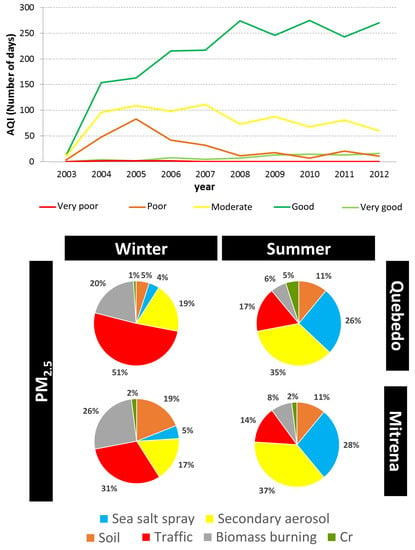Long-Term Assessment of Air Quality and Identification of Aerosol Sources at Setúbal, Portugal
Abstract
1. Introduction
2. Materials and Methods
2.1. Study Area
2.2. Monitoring of Air Pollutants by Air Quality Monitoring Networks
2.3. Particulate Matter Sampling and Characterisation
2.3.1. Sampling Sites and Methodology
2.3.2. Gravimetric Analysis
2.3.3. Chemical Analysis
2.4. Meteorological Data
2.5. Air Quality Index
2.6. Statistical Analysis and Source Apportionment
3. Results and Discussion
3.1. Meteorological Data
3.2. Air Quality Index (AQI)
3.3. Temporal Patterns of Air Pollutants
3.3.1. Annual Trends
3.3.2. Monthly Trends
3.3.3. Hourly Trends
3.4. Characterisation of Particulate Matter
3.4.1. Mass Concentrations
3.4.2. Chemical Characterisation
3.4.3. Identification of Emission Sources
- (1)
- Factor 1 was associated with soil since a high association with typical soil elements was found, namely Ca, Sc, Sm and La [42]. This crustal source contributed, on average, to 8% of the total PM2.5 mass in “Quebedo” and 15% in “Mitrena”. The contribution of this source was higher during daytime probably due to the resuspension related to traffic and due to an increase of the activities dealing with materials handling in the industrial area (“Mitrena”).
- (2)
- Factor 2 presented high associations between the water-soluble ions NH4+ and SO42− and the elements Co and Se, which are associated with secondary aerosols [47]. This source made an average contribution of 26% to the total PM2.5 mass in both monitoring stations. In both sites, a higher contribution was found in summer than in winter and contribution during day and night was similar.
- (3)
- Factor 3 was associated with sea salt spray since a high association was found between the water soluble ions Na+, Mg2+ and Cl−, which are associated with this source [42]. This source contributed around 15% to the total PM2.5 mass in both monitoring stations, with a higher contribution during summer probably due to the more intense sea breeze and the dominant S/SW winds registered during that season (Figure 3).
- (4)
- Factor 4 was characterized by water soluble ions K+ and Cl- and by As, which are associated with wood burning [48]. This source made a high contribution during the winter in both monitoring stations due to the use of wood burning for house heating. Overall, this source contributed, on average, 15% and 17% to the total PM2.5 in “Quebedo” and “Mitrena”, respectively.
- (5)
- Factor 5 was associated with a traffic source due to the high association between Sb, NO3-, As and Fe. NO3- is associated with car emissions and As and Sb are typically from mechanical abrasion of brakes and tires [37,42,49]. Fe may be associated with dust resuspension since this element is typically associated with crustal sources [42]. The traffic contribution was higher in “Quebedo” (34%) than in “Mitrena” monitoring station. In both monitoring stations, the contribution of this traffic source was higher in winter than in summer.
- (6)
- Factor 6 was characterized by Cr, which represents the industrial contribution [50] that was, on average, 3% and 2% for the monitoring stations “Quebedo” and “Mitrena”, respectively.
4. Conclusions
Supplementary Materials
Author Contributions
Funding
Conflicts of Interest
References
- Schraufnagel, D.E.; Balmes, J.R.; Cowl, C.T.; De Matteis, S.; Jung, S.H.; Mortimer, K.; Perez-Padilla, R.; Rice, M.B.; Riojas-Rodriguez, H.; Sood, A.; et al. Air Pollution and Noncommunicable Diseases: A Review by the Forum of International Respiratory Societies’ Environmental Committee, Part 1: The Damaging Effects of Air Pollution. Chest 2019, 155, 409–416. [Google Scholar] [CrossRef] [PubMed]
- WHO. Ambient Air Pollution: A Global Assessment of Exposure and Burden of Disease; World Health Organization: Geneva, Switzerland, 2016; ISBN 9789241511353. [Google Scholar]
- Kuklinska, K.; Wolska, L.; Namiesnik, J. Air quality policy in the U.S. and the EU—A review. Atmos. Pollut. Res. 2015, 6, 129–137. [Google Scholar] [CrossRef]
- European Environment Agency. Air Quality in Europe—2019 Report—EEA Report No 10/2019; Publications Office of the European Union: Brussels, Belgium, 2019. [Google Scholar]
- European Environment Agency. Air Quality in Europe—2017 Report—EEA Report No 13/2017; Publications Office of the European Union: Brussels, Belgium, 2017. [Google Scholar]
- Freitas, M.C.; Reis, M.A.; Marques, A.P.; Almeida, S.M.; Farinha, M.M.; De Oliveira, O.; Ventura, M.G.; Pacheco, A.M.G.; Barros, L.I.C. Monitoring of environmental contaminants: 10 Years of application of k 0-INAA. J. Radioanal. Nucl. Chem. 2003, 257, 621–625. [Google Scholar] [CrossRef]
- Farinha, M.M.; Almeida, S.M.; Freitas, M.C.; Verburg, T.G.; Wolterbeek, H.T. Influence of meteorological conditions on PM2.5 and PM 2.5–10 elemental concentrations on Sado estuary area, Portugal. J. Radioanal. Nucl. Chem. 2009, 282, 815–819. [Google Scholar] [CrossRef]
- Almeida, S.M.; Ramos, C.A.; Marques, A.M.; Silva, A.V.; Freitas, M.C.; Farinha, M.M.; Reis, M.; Marques, A.P. Use of INAA and PIXE for multipollutant air quality assessment and management. J. Radioanal. Nucl. Chem. 2012, 294, 343–347. [Google Scholar] [CrossRef]
- Almeida, S.M.; Silva, A.I.V.; Freitas, M.C.; Marques, A.M.; Ramos, C.A.; Silva, A.I.V.; Pinheiro, T. Characterization of dust material emitted during harbour activities by k0-INAA and PIXE. J. Radioanal. Nucl. Chem. 2012, 291, 77–82. [Google Scholar] [CrossRef]
- Silva, A.I.V.; Almeida, S.M.; Freitas, M.C.; Marques, A.M.; Silva, A.I.V.; Ramos, C.A.; Pinheiro, T. INAA and PIXE characterization of heavy metals and rare earth elements emissions from phosphorite handling in harbours. J. Radioanal. Nucl. Chem. 2012, 294, 277–281. [Google Scholar] [CrossRef]
- Garcia, S.M.; Domingues, G.; Gomes, C.; Silva, A.V.; Marta Almeida, S. Impact of road traffic emissions on ambient air quality in an industrialized area. J. Toxicol. Environ. Heal. Part A Curr. Issues 2013, 76, 429–439. [Google Scholar] [CrossRef]
- INE—Instituto Nacional de Estatística. Censos 2011 Resultados Definitivos; Instituto Nacional de Estatística I.P.: Lisboa, Portugal, 2011. [Google Scholar]
- Agência Portuguesa do Ambiente (APA). Manual de Métodos e de procedimentos operativos das redes de monitorização da Qualidade do Ar—Amostragem e análise; Agência Portuguesa do Ambiente: Lisboa, Portugal, 2010. [Google Scholar]
- Maenhaut, W.; Francois, F.; Cafmeyer, J. The “Gent” Stacked Filter Unit (SFU) Sampler for the Collection of Atmospheric Aerosols in Two Size Fractions: Description and Instructions for Installation and Use; International Atomic Energy Agency: Vienna, Austria, 1994; pp. 249–263. [Google Scholar]
- Almeida, S.M.; Freitas, M.C.; Reis, M.; Pinheiro, T.; Felix, P.M.; Pio, C.A. Fifteen years of nuclear techniques application to suspended particulate matter studies. J. Radioanal. Nucl. Chem. 2013, 297, 347–356. [Google Scholar] [CrossRef]
- Dung, H.M.; Freitas, M.C.; Blaauw, M.; Almeida, S.M.; Dionisio, I.; Canha, N.H. Quality control and performance evaluation of k0-based neutron activation analysis at the Portuguese research reactor. Nuclear Instrum. Meth. Phys. Res. Sect. A Accel. Spectrometers Spectrome Assoc. Equip. 2010, 622, 392–398. [Google Scholar] [CrossRef]
- Almeida, S.M.; Almeida-Silva, M.; Galinha, C.; Ramos, C.A.; Lage, J.; Canha, N.; Silva, A.V.; Bode, P. Assessment of the Portuguese k 0-INAA laboratory performance by evaluating internal quality control data. J. Radioanal. Nucl. Chem. 2014, 300, 581–587. [Google Scholar] [CrossRef]
- EMEP. EMEP Manual for Sampling and Chemical Analysis; EMEP: Kjeller, Norway, 2001. [Google Scholar]
- Carslaw, D.C.; Ropkins, K. Openair—An r package for air quality data analysis. Environ. Model. Softw. 2012, 27, 52–61. [Google Scholar] [CrossRef]
- European Environment Agency. European Air Quality Index. Available online: https://airindex.eea.europa.eu/ (accessed on 16 September 2019).
- United States Environmental Protection Agency. AirNow. Available online: https://airnow.gov/ (accessed on 16 September 2019).
- Bao, J.; Yang, X.; Zhao, Z.; Wang, Z.; Yu, C.; Li, X. The Spatial-Temporal Characteristics of Air Pollution in China from 2001–2014. Int. J. Environ. Res. Public Health 2015, 12, 15875–15887. [Google Scholar] [CrossRef] [PubMed]
- Monteiro, A.; Vieira, M.; Gama, C.; Miranda, A.I. Towards an improved air quality index. Air Qual. Atmos. Health 2017, 10, 447–455. [Google Scholar] [CrossRef]
- APA. QualAR—Qualidade do AR. Available online: https://qualar.apambiente.pt/node/indice-qualar (accessed on 16 September 2019).
- United States Environmental Protection Agency. Positive Matrix Factorization Model for Environmental data Analyses; U.S. Environmental Protection Agency: Washington, DC, USA, 2014.
- Canha, N.; Almeida, S.M.; do Carmo Freitas, M.; Wolterbeek, H.T.; Cardoso, J.; Pio, C.; Caseiro, A. Impact of wood burning on indoor PM2.5in a primary school in rural Portugal. Atmos. Environ. 2014, 94, 663–670. [Google Scholar] [CrossRef]
- Monteiro, A.; Russo, M.; Gama, C.; Lopes, M.; Borrego, C. How economic crisis influence air quality over Portugal (Lisbon and Porto)? Atmos. Pollut. Res. 2018, 9, 439–445. [Google Scholar] [CrossRef]
- Almeida, S.M.; Silva, A.I.; Freitas, M.C.; Dzung, H.M.; Caseiro, A.; Pio, C.A. Impact of maritime air mass trajectories on the western european coast urban aerosol. J. Toxicol. Environ. Heal. Part A Curr. Issues 2013, 76, 252–262. [Google Scholar] [CrossRef][Green Version]
- WHO. Air Quality Guidelines for Particulate Matter, Ozone, Nitrogen Dioxide and Sulfur Dioxide: Global Update 2005: Summary of Risk Assessment; World Health Organization: Geneva, Switzerland, 2006. [Google Scholar]
- Guerreiro, C.B.B.; Foltescu, V.; de Leeuw, F. Air quality status and trends in Europe. Atmos. Environ. 2014, 98, 376–384. [Google Scholar] [CrossRef]
- Dayan, U.; Ricaud, P.; Zbinden, R.; Dulac, F. Atmospheric pollution over the eastern Mediterranean during summer—A review. Atmos. Chem. Phys. 2017, 17, 13233–13263. [Google Scholar] [CrossRef]
- Adame, J.A.; Sole, J.G. Surface ozone variations at a rural area in the northeast of the Iberian Peninsula. Atmos. Pollut. Res. 2013, 4, 130–141. [Google Scholar] [CrossRef]
- European Environment Agency. Air Quality in Europe—2013 Report—European Environment Agency; Publications Office of the European Union: Brussels, Belgium, 2013. [Google Scholar]
- Zabalza, J.; Ogulei, D.; Elustondo, D.; Santamaría, J.M.; Alastuey, A.; Querol, X.; Hopke, P.K. Study of urban atmospheric pollution in Navarre (Northern Spain). Environ. Monit. Assess. 2007, 134, 137–151. [Google Scholar] [CrossRef] [PubMed]
- Ta, W.; Wang, T.; Xiao, H.; Zhu, X.; Xiao, Z. Gaseous and particulate air pollution in the Lanzhou Valley, China. Sci. Total Environ. 2004, 320, 163–176. [Google Scholar] [CrossRef] [PubMed]
- Yan, Y.; Lin, J.; Pozzer, A.; Kong, S.; Lelieveld, J. Trend reversal from high-to-low and from rural-to-urban ozone concentrations over Europe. Atmos. Environ. 2019, 213, 25–36. [Google Scholar] [CrossRef]
- Almeida-Silva, M.; Canha, N.; Freitas, M.C.; Dung, H.M.; Dionísio, I. Air pollution at an urban traffic tunnel in Lisbon, Portugal-an INAA study. Appl. Radiat. Isot. 2011, 69. [Google Scholar] [CrossRef]
- Vecchi, R.; Marcazzan, G.; Valli, G. A study on nighttime-daytime PM10 concentration and elemental composition in relation to atmospheric dispersion in the urban area of Milan (Italy). Atmos. Environ. 2007, 41, 2136–2144. [Google Scholar] [CrossRef]
- Latif, M.T.; Dominick, D.; Ahamad, F.; Khan, M.F.; Juneng, L.; Hamzah, F.M.; Nadzir, M.S.M. Long term assessment of air quality from a background station on the Malaysian Peninsula. Sci. Total Environ. 2014, 482, 336–348. [Google Scholar] [CrossRef]
- Almeida, S.M.; Lage, J.; Fernández, B.; Garcia, S.; Reis, M.A.; Chaves, P.C. Chemical characterization of atmospheric particles and source apportionment in the vicinity of a steelmaking industry. Sci. Total Environ. 2015, 521–522, 411–420. [Google Scholar] [CrossRef]
- Casquero-Vera, J.A.; Lyamani, H.; Titos, G.; Borrás, E.; Olmo, F.J.; Alados-Arboledas, L. Impact of primary NO2 emissions at different urban sites exceeding the European NO2 standard limit. Sci. Total Environ. 2019, 646, 1117–1125. [Google Scholar] [CrossRef]
- Calvo, A.I.; Alves, C.; Castro, A.; Pont, V.; Vicente, A.M.; Fraile, R. Research on aerosol sources and chemical composition: Past, current and emerging issues. Atmos. Res. 2013, 120, 1–28. [Google Scholar] [CrossRef]
- Karagulian, F.; Belis, C.A.; Dora, C.F.C.; Prüss-Ustün, A.M.; Bonjour, S.; Adair-Rohani, H.; Amann, M. Contributions to cities’ ambient particulate matter (PM): A systematic review of local source contributions at global level. Atmos. Environ. 2015, 120, 475–483. [Google Scholar] [CrossRef]
- Almeida, S.M.; Freitas, M.C.; Repolho, C.; Dionísio, I.; Dung, H.M.; Pio, C.A.; Alves, C.; Caseiro, A.; Pacheco, A.M.G. Evaluating children exposure to air pollutants for an epidemiological study. J. Radioanal. Nucl. Chem. 2009, 280, 405–409. [Google Scholar] [CrossRef]
- Almeida, S.M.; Pio, C.A.; Freitas, M.C.; Reis, M.A.; Trancoso, M.A. Source apportionment of fine and coarse particulate matter in a sub-urban area at the Western European Coast. Atmos. Environ. 2005, 39, 3127–3138. [Google Scholar] [CrossRef]
- Vicente, A.; Alves, C.; Calvo, A.I.; Fernandes, A.P.; Nunes, T.; Monteiro, C.; Almeida, S.M.; Pio, C. Emission factors and detailed chemical composition of smoke particles from the 2010 wildfire season. Atmos. Environ. 2013, 71, 295–303. [Google Scholar] [CrossRef]
- Canha, N.; Almeida, S.M.; Freitas, M.D.C.; Trancoso, M.; Sousa, A.; Mouro, F.; Wolterbeek, H.T. Particulate matter analysis in indoor environments of urban and rural primary schools using passive sampling methodology. Atmos. Environ. 2014, 83, 21–34. [Google Scholar] [CrossRef]
- Canha, N.; Freitas, M.C.; Almeida-Silva, M.; Almeida, S.M.; Dung, H.M.; Dionísio, I.; Cardoso, J.; Pio, C.A.; Caseiro, A.; Verburg, T.G.; et al. Burn wood influence on outdoor air quality in a small village: Foros de Arrão, Portugal. J. Radioanal. Nucl. Chem. 2012, 291, 83–88. [Google Scholar] [CrossRef]
- Grigoratos, T.; Martini, G. Brake wear particle emissions: A review. Environ. Sci. Pollut. Res. 2015, 22, 2491–2504. [Google Scholar] [CrossRef]
- Cesari, D.; Genga, A.; Ielpo, P.; Siciliano, M.; Mascolo, G.; Grasso, F.M.; Contini, D. Source apportionment of PM2.5 in the harbour-industrial area of Brindisi (Italy): Identification and estimation of the contribution of in-port ship emissions. Sci. Total Environ. 2014, 497, 392–400. [Google Scholar] [CrossRef]
- European Commission. Directive 2008/50/EC of the European Parliament and of the Council of 21 May 2008 on ambient air quality and cleaner air for Europe. Off. J. Eur. Union 2008, 151, 1–44. [Google Scholar]
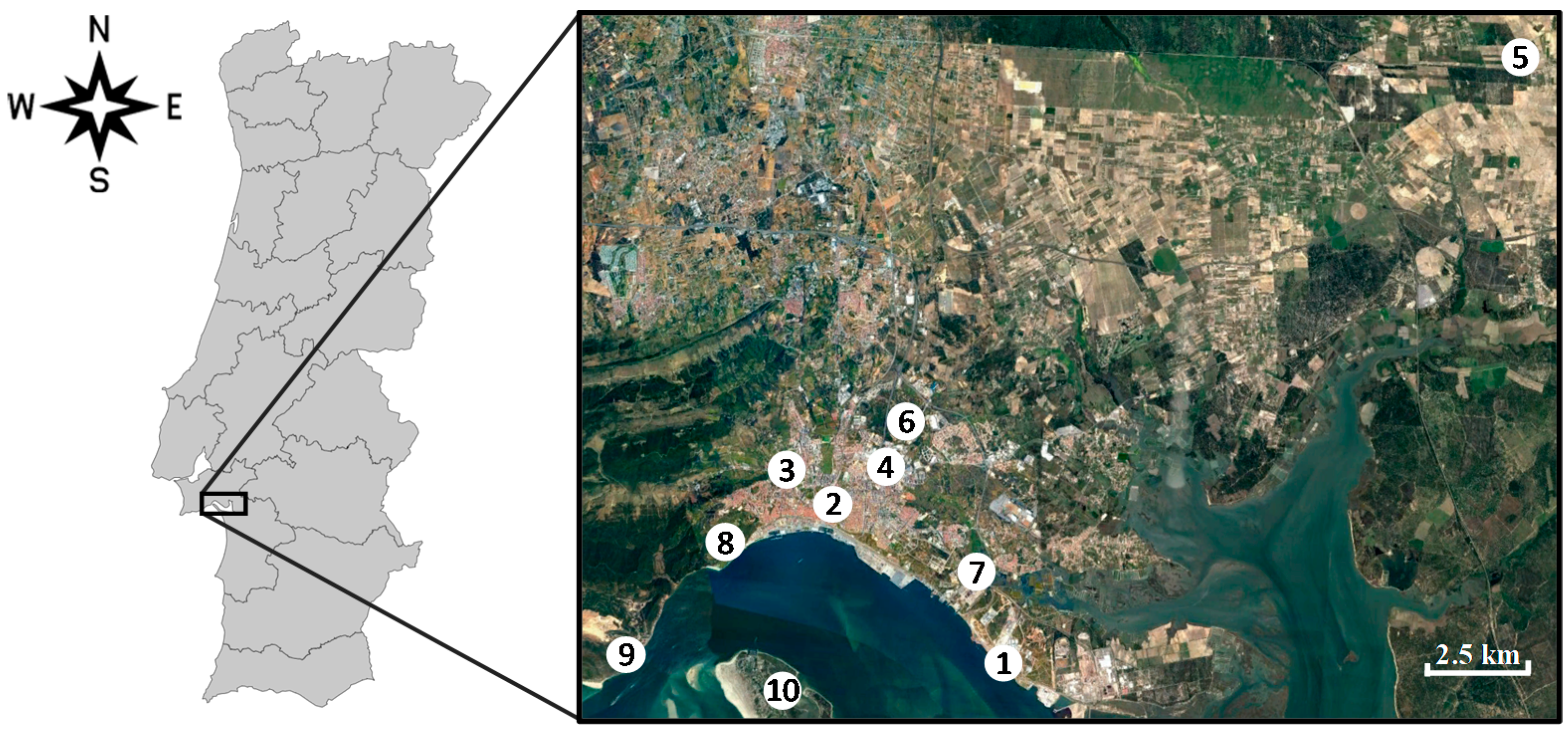


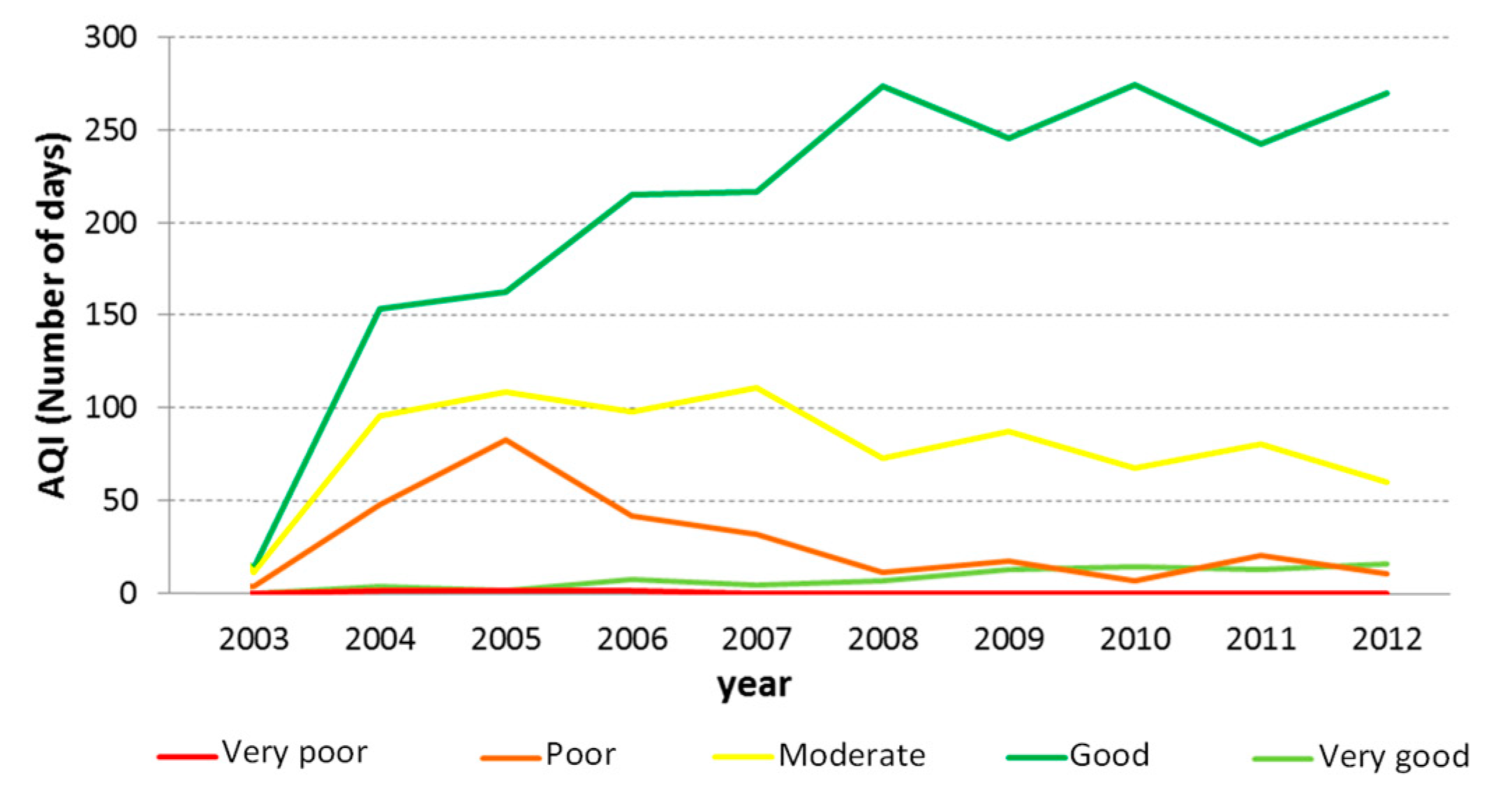
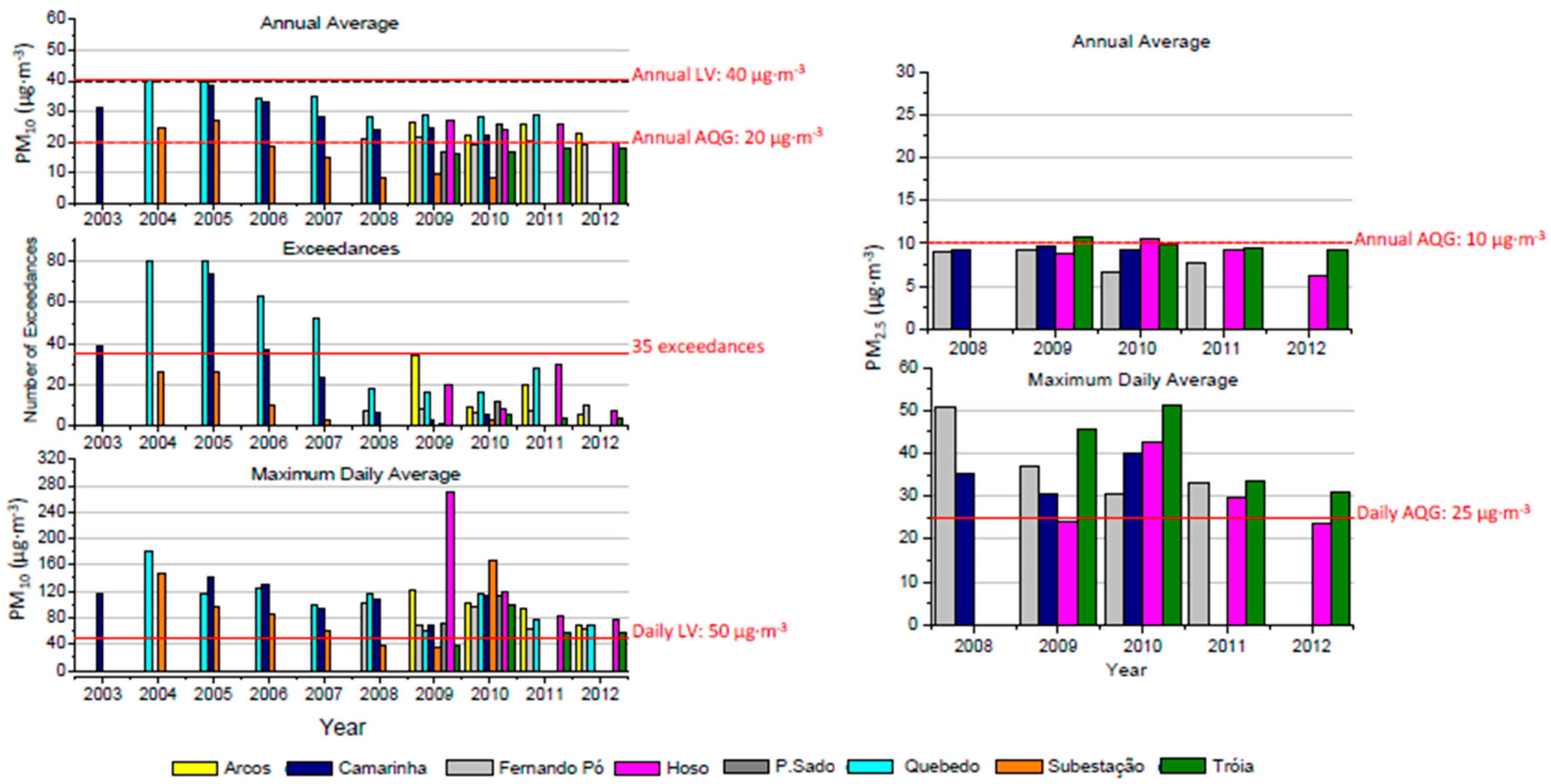
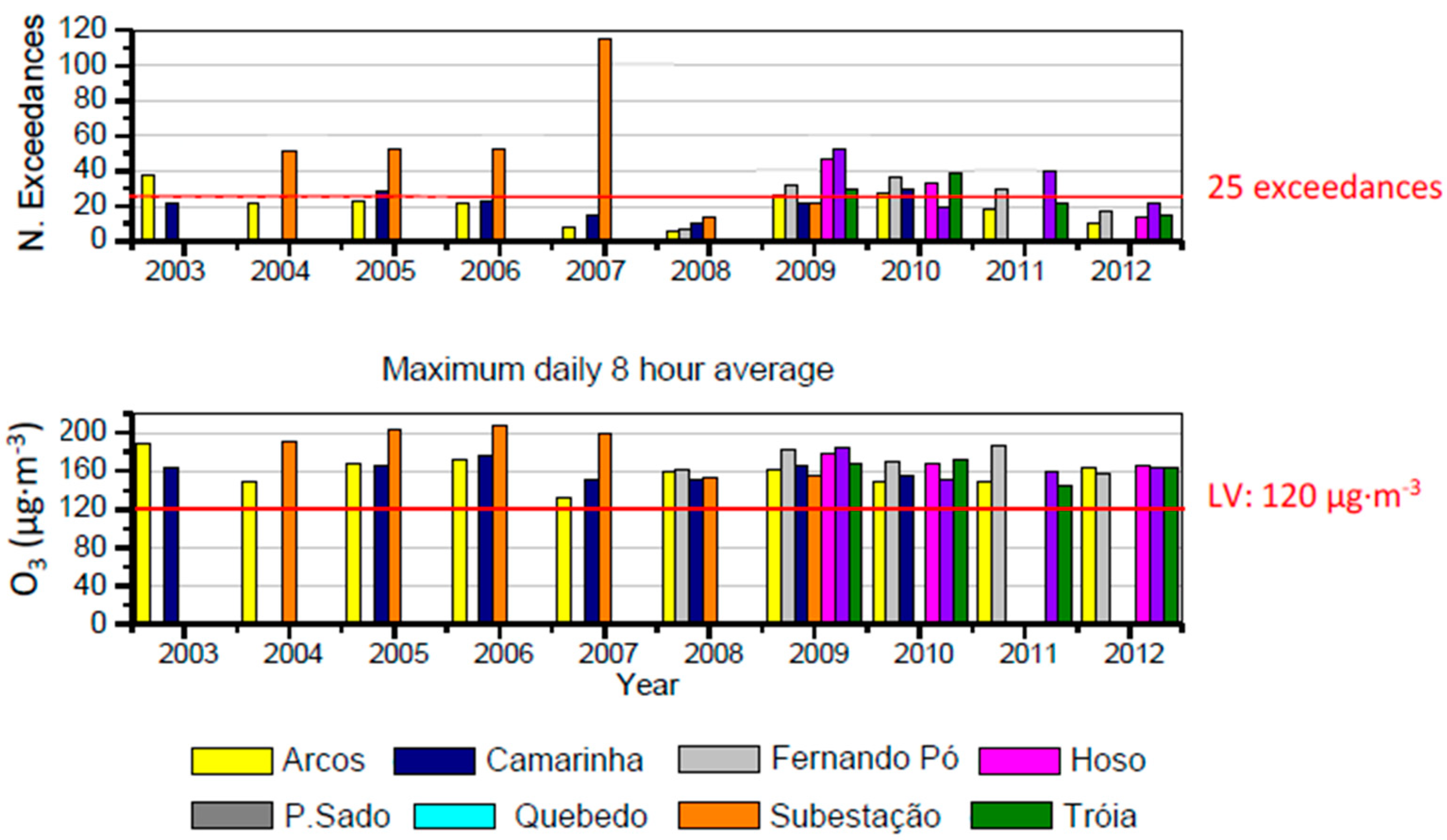
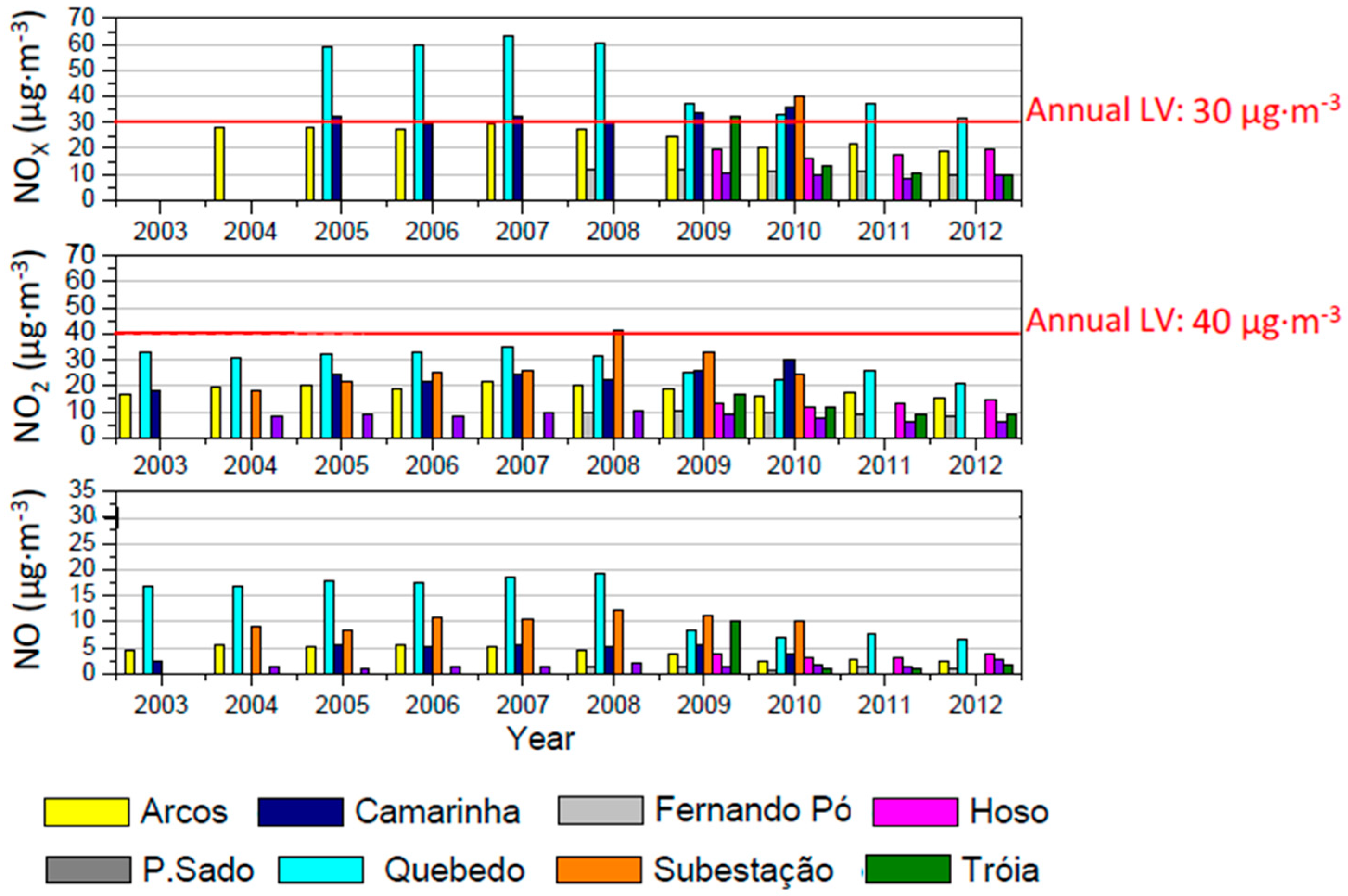
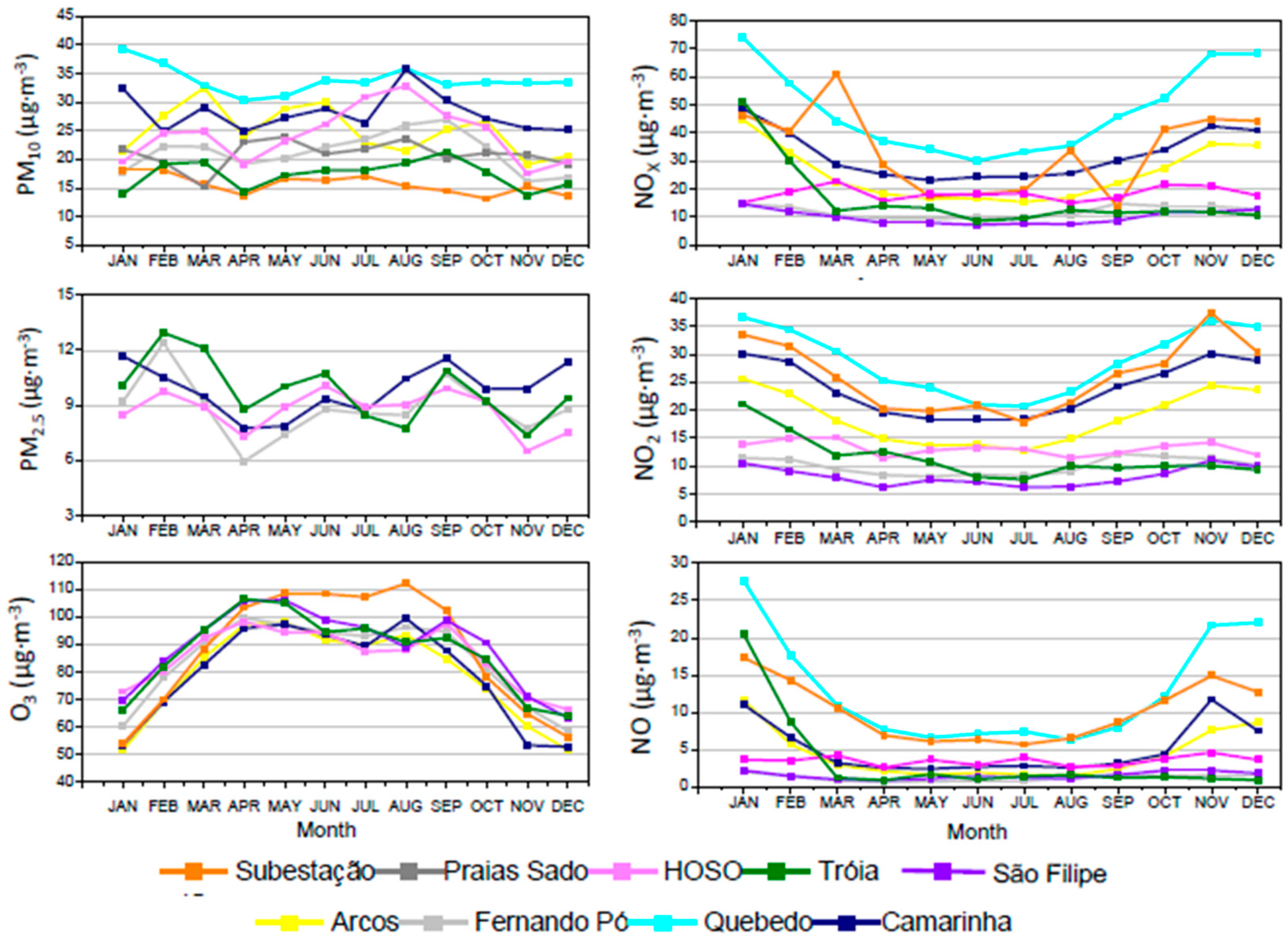
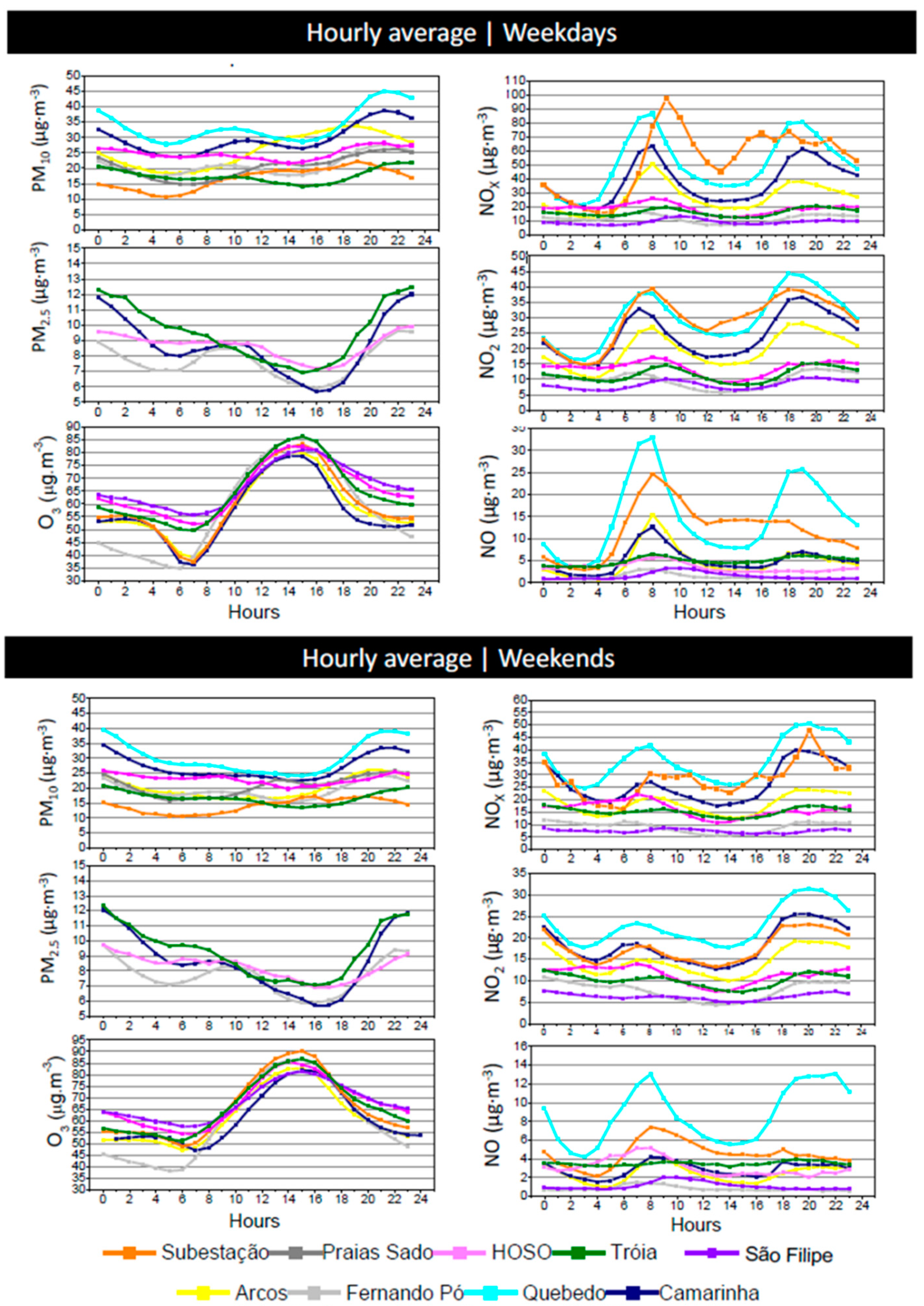
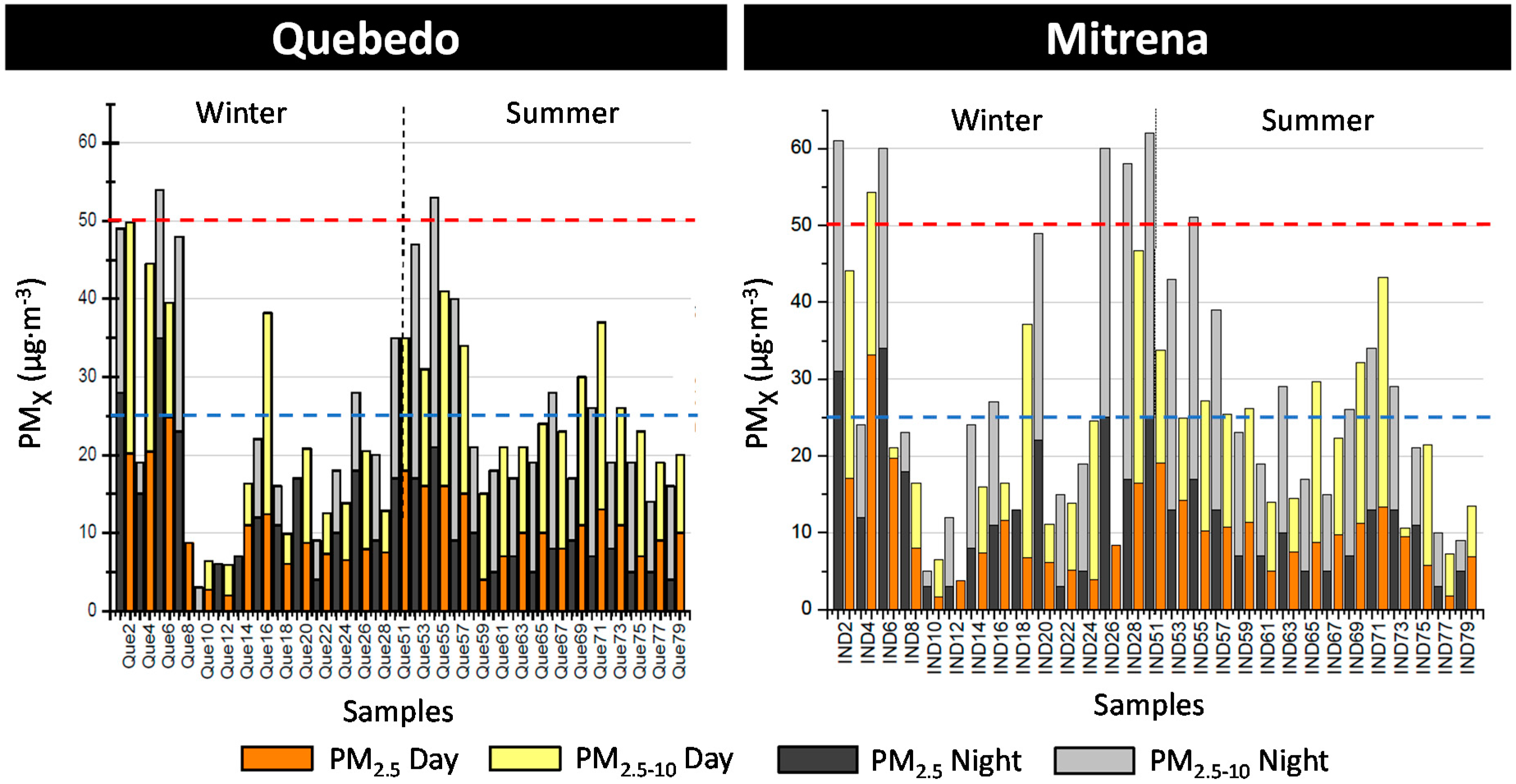

| Network | #ID | Stations | Coordinates | Altitude (m) | Type | Pollutants Monitored | Sampling Period for Each Pollutant | |
|---|---|---|---|---|---|---|---|---|
| Latitude | Longitude | |||||||
| This study | 1 | INDUSTRIAL MITRENA | 38°29’48’’N | 08°49’58’’W | – | Suburban Industrial | PM2.5–10 and PM2.5 mass and chemical composition | PM: 2011 |
| chemical constituents: 2011 | ||||||||
| 2 | QUEBEDO | 38°31’27’’N | 08°53’39’’W | 16 | Urban Traffic | PM2.5–10 and PM2.5 mass and chemical composition | PM: 2011 | |
| chemical constituents: 2011 | ||||||||
| APA–QUALAR | QUEBEDO | 38°31’27’’N | 08°53’39’’W | 16 | Urban Traffic | NO, NO2, NOX, PM10 | NO, NO2: 2003–2012 | |
| 2 | NOx: 2005–2012 | |||||||
| PM10: 2004–2011 | ||||||||
| 3 | ARCOS | 38°31’46’’N | 08°53’39’’W | 2 | Urban Background | NO, NO2, NOX, O3, PM10 | NO, NO2, O3: 2003–2012 | |
| NOx: 2004–2012 | ||||||||
| PM10: 2009–2012 | ||||||||
| 4 | CAMARINHA | 38°31’50’’N | 08°52’23’’W | 15 | Urban Background | NO, NO2, NOX, PM2.5, PM10, O3 | NO, NO2, O3, PM10: 2003 | |
| NOx: 2005–2010 | ||||||||
| PM2.5: 2008–2010 | ||||||||
| 5 | FERNANDO PÓ | 38°38’08’’N | 08°41’26’’W | 57 | Rural Background | NO, NO2, NOX, O3, PM2.5, PM10 | 2008–2011 | |
| EDP | 6 | SUBESTAÇÃO | 38°32’08’’N | 08°51’44’’W | 30 | Suburban Traffic | NO, NO2, NOX, PM10, O3 | NO, NO2, O3, PM10: 2004–2010 |
| NOx: 2010 | ||||||||
| 7 | PRAIAS SADO | 38°31’05’’N | 08°50’15’’W | – | Suburban Industrial | PM10 | PM10: 2009–2010 | |
| SECIL | 8 | SÃO FILIPE | 38°30’55’’N | 08°54’40’’W | 110 | Suburban Background | NO, NO2, NOX, O3 | NO, NO2: 2004–2012 |
| NOx, O3: 2009–2012 | ||||||||
| 9 | HOSO | 38°29’31’’N | 08°56’02’’W | – | Suburban Industrial | NO, NO2, NOX, PM2.5, PM10, O3 | NO, NO2, NOX, O3, PM2.5: 2009–2012 | |
| PM10: 2010–2012 | ||||||||
| 10 | TRÓIA | 38°28’45’’N | 08°53’20’’W | 3 | Suburban Background | NO, NO2, NOX, PM2.5, PM10, O3 | 2009–2012 | |
| Index Class | Mandatory Pollutant | Auxiliary Pollutant | |||
|---|---|---|---|---|---|
| NO2 (1 h) | O3 (1 h) | PM10 (24 h) | SO2 (1 h) | CO (8 h) | |
| Very good | [0–99] | [0–59] | [0–19] | [0–139] | [0–4999] |
| Good | [100–139] | [60–119] | [20–34] | [140–209] | [5000–6999] |
| Moderate | [140–199] | [120–179] | [35–49] | [210–349] | [7000–8499] |
| Poor | [200–399] | [180–239] | [50–119] | [350–499] | [8500–9999] |
| Very poor | ≥400 | ≥240 | ≥120 | ≥500 | ≥10,000 |
| Parameter | Unit | Annually | Winter | Summer | |||||||||||
|---|---|---|---|---|---|---|---|---|---|---|---|---|---|---|---|
| PM2.5 | PM2.5–10 | PM2.5 | PM2.5–10 | PM2.5 | PM2.5–10 | ||||||||||
| 24 h | Day | Night | 24 h | Day | Night | 24 h | Day | Night | 24 h | Day | Night | ||||
| PMX | µg·m−3 | 11.3 ± 6.6 | 14.1 ± 7.7 | 12.7 ± 8.1 | 10.4 ± 6.8 | 15.0 ± 8.9 | 11.7 ± 8.2 | 11.8 ± 9.2 | 11.7 ± 7.4 | 9.87 ± 4.47 | 11.0 ± 3.9 | 8.68 ± 4.85 | 16.2 ± 6.7 | 15.6 ± 4.6 | 16.8 ± 8.5 |
| Cl− | ng·m−3 | 195 ± 181 | 971 ± 974 | 195 ± 200 | 154 ± 142 | 234 ± 241 | 444 ± 504 | 472 ± 565 | 416 ± 453 | 195 ± 162 | 220 ± 176 | 168 ± 149 | 1480 ± 1050 | 1100 ± 700 | 1890 ± 1230 |
| NO3− | 1070 ± 1130 | 1070 ± 790 | 1620 ± 1330 | 1160 ± 910 | 2060 ± 1540 | 858 ± 715 | 869 ± 834 | 847 ± 614 | 487 ± 333 | 582 ± 393 | 392 ± 237 | 1290 ± 820 | 1240 ± 840 | 1330 ± 820 | |
| SO42− | 1230 ± 990 | 392 ± 326 | 907 ± 699 | 847 ± 665 | 964 ± 748 | 320 ± 312 | 317 ± 310 | 322 ± 325 | 1550 ± 1140 | 1490 ± 800 | 1620 ± 1430 | 465 ± 328 | 372 ± 234 | 564 ± 390 | |
| Na+ | 239 ± 241 | 831 ± 728 | 74.6 ± 59.8 | 75.2 ± 60.9 | 74.1 ± 61.4 | 340 ± 337 | 340 ± 350 | 341 ± 336 | 387 ± 247 | 419 ± 263 | 353 ± 233 | 1310 ± 690 | 1060 ± 580 | 1570 ± 720 | |
| NH4+ | 519 ± 472 | 53.3 ± 45.9 | 619 ± 558 | 474 ± 446 | 753 ± 631 | 61.6 ± 47.0 | 50.9 ± 41.1 | 72.2 ± 51.6 | 419 ± 346 | 419 ± 314 | 418 ± 390 | 45.0 ± 44.0 | 28.8 ± 22.4 | 61.2 ± 54.4 | |
| K+ | 126 ± 141 | 74 ± 102 | 187 ± 172 | 147 ± 107 | 224 ± 213 | 66.0 ± 60.6 | 68.0 ± 60.9 | 64.2 ± 62.3 | 64.4 ± 57.5 | 57.3 ± 31.0 | 71.9 ± 77.3 | 81 ± 132 | 48.6 ± 26.6 | 116 ± 186 | |
| Mg2+ | 23.5 ± 21.2 | 85.9 ± 64.6 | 9.94 ± 5.90 | 10.2 ± 5.58 | 9.72 ± 6.37 | 43.8 ± 29.6 | 46.2 ± 31.6 | 41.4 ± 28.4 | 37.0 ± 22.4 | 41.1 ± 22.8 | 32.5 ± 21.9 | 128 ± 63 | 111 ± 57 | 146 ± 66 | |
| Ca2+ | 210 ± 185 | 836 ± 829 | 192 ± 204 | 227 ± 228 | 150 ± 173 | 957 ± 1060 | 1210 ± 1250 | 708 ± 795 | 225 ± 169 | 266 ± 175 | 177 ± 156 | 724 ± 511 | 786 ± 329 | 658 ± 660 | |
| Ion balance | n/a | 1.65 ± 2.22 | 2.25 ± 1.22 | 1.21 ± 0.23 | 1.31 ± 0.18 | 1.11 ± 0.24 | 2.71 ± 1.40 | 3.23 ± 1.73 | 2.35 ± 0.93 | 2.08 ± 3.10 | 2.71 ± 4.27 | 1.40 ± 0.27 | 1.80 ± 0.79 | 1.88 ± 0.47 | 1.71 ± 1.00 |
| As | ng·m−3 | 0.46 ± 0.44 | 0.17 ± 0.13 | 0.63 ± 0.41 | 0.67 ± 0.45 | 0.58 ± 0.39 | 0.16 ± 0.12 | 0.18 ± 0.14 | 0.14 ± 0.10 | 0.04 ± 0.04 | 0.04 ± 0.04 | 0.04 ± 0.06 | 0.22 ± 0.18 | 0.17 ± 0.22 | 0.32 |
| Ce | 0.35 ± 0.24 | 0.28 ± 0.14 | 0.35 ± 0.25 | 0.40 ± 0.29 | 0.30 ± 0.21 | 0.25 ± 0.13 | 0.21 ± 0.12 | 0.32 ± 0.16 | 0.35 ± 0.26 | 0.38 ± 0.36 | 0.31 ± 0.08 | n.a. | n.a. | <LoD | |
| Co | 0.09 ± 0.12 | 5.19 ± 13.3 | 0.13 ± 0.17 | 0.13 ± 0.20 | 0.11 ± 0.11 | 0.05 ± 0.05 | 0.05 ± 0.06 | 0.05 ± 0.05 | 0.07 ± 0.05 | 0.07 ± 0.06 | 0.07 ± 0.05 | 18.6 ± 21.1 | 6.18 ± 8.12 | 37.1 ± 22.2 | |
| Cr | 3.55 ± 2.72 | 7.93 ± 5.13 | 1.29 ± 0.99 | 1.10 ± 0.78 | 1.61 ± 1.41 | 5.08 ± 3.16 | 4.94 ± 2.80 | 5.22 ± 3.58 | 4.41 ± 2.68 | 4.86 ± 2.48 | 3.99 ± 2.90 | 13.2 ± 3.62 | 12.7 ± 2.50 | 13.6 ± 4.32 | |
| Cs | 0.68 ± 2.61 | 0.06 ± 0.01 | 0.06 ± 0.04 | 0.07 ± 0.03 | 0.05 ± 0.06 | 0.06 ± 0.01 | 0.06 ± 0.01 | <LoD | 1.09 ± 3.36 | 0.07 ± 0.09 | 2.12 ± 4.72 | <LoD | <LoD | <LoD | |
| Fe | 138 ± 96 | 286 ± 236 | 153 ± 96 | 159 ± 88 | 147 ± 105 | 294 ± 262 | 348 ± 278 | 232 ± 238 | 121 ± 95 | 138 ± 113 | 99.9 ± 66.9 | 254 ± 95 | 293 ± 102 | 201 ± 66 | |
| K | 137 ± 122 | 99.0 ± 62.8 | 184 ± 130 | 154 ± 117 | 212 ± 138 | 89.2 ± 66.5 | 100 ± 73 | 77.9 ± 59.7 | 61.7 ± 49.2 | 62.3 ± 46.5 | 60.9 ± 55.6 | 119 ± 51 | 106 ± 37 | 133 ± 65 | |
| La | 0.06 ± 0.06 | 0.15 ± 0.13 | 0.06 ± 0.03 | 0.06 ± 0.04 | 0.05 ± 0.02 | 0.09 ± 0.09 | 0.10 ± 0.10 | 0.09 ± 0.09 | 0.07 ± 0.08 | 0.06 ± 0.09 | 0.07 ± 0.07 | 0.23 ± 0.14 | 0.23 ± 0.17 | 0.23 ± 0.12 | |
| Na | 194 ± 181 | 697 ± 618 | 65.7 ± 47.0 | 61.1 ± 39.0 | 69.9 ± 54.5 | 302 ± 304 | 301 ± 294 | 303 ± 324 | 322 ± 175 | 348 ± 181 | 293 ± 170 | 1120 ± 590 | 852 ± 516 | 1410 ± 540 | |
| Sb | 0.64 ± 0.46 | 0.71 ± 0.71 | 0.82 ± 0.51 | 0.82 ± 0.39 | 0.83 ± 9.61 | 0.95 ± 0.76 | 1.18 ± 0.76 | 0.73 ± 0.72 | 0.43 ± 0.26 | 0.41 ± 0.21 | 0.44 ± 0.32 | 0.23 ± 0.14 | 0.26 ± 0.17 | 0.18 ± 0.08 | |
| Sc | 0.02 ± 0.02 | 0.05 ± 0.04 | 0.01 ± 0.01 | 0.01 ± 0.01 | 0.01 ± 0.01 | 0.02 ± 0.02 | 0.03 ± 0.02 | 0.02 ± 0.01 | 0.02 ± 0.03 | 0.02 ± 0.03 | 0.02 ± 0.02 | 0.06 ± 0.04 | 0.07 ± 0.03 | 0.06 ± 0.04 | |
| Se | 0.29 ± 0.23 | 0.07 ± 0.05 | 0.30 ± 0.27 | 0.20 ± 0.21 | 0.37 ± 0.30 | 0.07 ± 0.05 | 0.02 ± 0.02 | 0.10 ± 0.04 | 0.29 ± 0.20 | 0.24 ± 0.17 | 0.34 ± 0.22 | <LoD | <LoD | <LoD | |
| Sm | 0.01 ± 0.01 | 0.04 ± 0.06 | 0.01 ± 0.00 | 0.01 ± 0.01 | 0.01 ± 0.00 | 0.02 ± 0.02 | 0.02 ± 0.02 | 0.02 ± 0.01 | 0.02 ± 0.02 | 0.02 ± 0.03 | 0.01 ± 0.01 | 0.07 ± 0.10 | 0.03 ± 0.01 | 0.10 ± 0.13 | |
| Zn | 11.0 ± 12.0 | 13.9 ± 14.3 | 13.4 ± 15.8 | 15.2 ± 14.0 | 11.8 ± 17.4 | 13.2 ± 14.1 | 12.7 ± 12.0 | 13.8 ± 17.3 | 8.44 ± 4.77 | 8.94 ± 5.38 | 7.93 ± 4.22 | 19.8 ± 17.9 | 19.8 ± 17.9 | <LoD | |
| Parameter | Unit | Annually | Winter | Summer | |||||||||||
|---|---|---|---|---|---|---|---|---|---|---|---|---|---|---|---|
| PM2.5 | PM2.5–10 | PM2.5 | PM2.5-10 | PM2.5 | PM2.5–10 | ||||||||||
| 24 h | Day | Night | 24 h | Day | Night | 24 h | Day | Night | 24 h | Day | Night | ||||
| PMX | µg·m−3 | 11.2 ± 7.5 | 15.7 ± 10.0 | 13.0 ± 9.6 | 10.6 ± 8.2 | 15.3 ± 10.3 | 16.4 ± 11.7 | 13.8 ± 9.7 | 18.8 ± 12.9 | 9.44 ± 4.10 | 9.69 ± 4.03 | 9.18 ± 4.16 | 15.1 ± 8.1 | 13.8 ± 9.7 | 16.9 ± 8.6 |
| Cl− | ng·m−3 | 456 ± 685 | 1050 ± 900 | 437 ± 692 | 265 ± 243 | 597 ± 917 | 479 ± 552 | 402 ± 471 | 550 ± 613 | 476 ± 689 | 308 ± 218 | 656 ± 949 | 1620 ± 820 | 1320 ± 740 | 1940 ± 760 |
| NO3− | 917 ± 920 | 996 ± 735 | 1320 ± 1120 | 907 ± 752 | 1700 ± 1280 | 670 ± 495 | 574 ± 471 | 760 ± 500 | 519 ± 369 | 556 ± 415 | 480 ± 303 | 1320 ± 800 | 1220 ± 740 | 1430 ± 840 | |
| SO42− | 1570 ± 1120 | 726 ± 473 | 1310 ± 1010 | 1310 ± 1110 | 1310 ± 910 | 613 ± 494 | 556 ± 392 | 666 ± 573 | 1820 ± 1170 | 1790 ± 1100 | 1860 ± 1250 | 840 ± 430 | 751 ± 469 | 936 ± 355 | |
| Na+ | 294 ± 371 | 751 ± 662 | 88.2 ± 66.4 | 98.4 ± 72.0 | 78.8 ± 58.6 | 314 ± 343 | 281 ± 298 | 344 ± 379 | 499 ± 434 | 504 ± 267 | 494 ± 569 | 1190 ± 610 | 1040 ± 610 | 1350 ± 570 | |
| NH4+ | 534 ± 483 | 136 ± 224 | 552 ± 568 | 452 ± 524 | 646 ± 593 | 124 ± 152 | 83.0 ± 64.2 | 161 ± 198 | 516 ± 388 | 451 ± 341 | 585 ± 425 | 149 ± 280 | 98 ± 139 | 203 ± 374 | |
| K+ | 146 ± 151 | 146 ± 117 | 201 ± 196 | 170 ± 101 | 230 ± 254 | 138 ± 83 | 123 ± 65 | 152 ± 95 | 90.8 ± 40.7 | 101 ± 46 | 80.0 ± 29.2 | 155 ± 144 | 147 ± 90 | 163 ± 188 | |
| Mg2+ | 35.0 ± 63.5 | 93 ± 103 | 29.5 ± 88.1 | 16.8 ± 9.8 | 41 ± 123 | 70 ± 130 | 48.4 ± 39.7 | 90 ± 176 | 39.9 ± 19.5 | 44.0 ± 21.3 | 35.5 ± 15.8 | 117 ± 61 | 98.0 ± 56.5 | 137 ± 60 | |
| Ca2+ | 280 ± 261 | 1080 ± 1180 | 331 ± 313 | 334 ± 294 | 329 ± 332 | 1470 ± 1480 | 1150 ± 920 | 1780 ± 1820 | 229 ± 187 | 288 ± 208 | 166 ± 130 | 684 ± 565 | 694 ± 559 | 674 ± 572 | |
| Ion balance | n/a | 1.29 ± 0.57 | 2.33 ± 1.61 | 1.28 ± 0.75 | 1.40 ± 0.64 | 1.19 ± 0.84 | 3.35 ± 1.74 | 3.52 ± 1.80 | 3.20 ± 1.73 | 1.29 ± 0.32 | 1.38 ± 0.36 | 1.20 ± 0.26 | 1.35 ± 0.49 | 1.41 ± 0.62 | 1.29 ± 0.31 |
| As | ng·m−3 | 0.87 ± 3.14 | 0.66 ± 1.64 | 1.49 ± 4.38 | 2.17 ± 6.06 | 0.85 ± 0.85 | 0.30 ± 0.37 | 0.33 ± 0.45 | 0.28 ± 0.26 | 0.25 ± 0.26 | 0.26 ± 0.27 | 0.24 ± 0.24 | 1.01 ± 2.25 | 0.57 ± 1.01 | 1.49 ± 3.04 |
| Ce | 0.11 ± 0.12 | 0.33 ± 0.31 | 0.13 ± 0.13 | 0.12 ± 0.10 | 0.14 ± 0.16 | 0.39 ± 0.39 | 0.30 ± 0.26 | 0.47 ± 0.47 | 0.09 ± 0.11 | 0.10 ± 0.12 | 0.08 ± 0.10 | 0.28 ± 0.22 | 0.24 ± 0.18 | 0.32 ± 0.24 | |
| Co | 0.04 ± 0.05 | 0.09 ± 0.07 | 0.04 ± 0.05 | 0.04 ± 0.07 | 0.03 ± 0.03 | 0.09 ± 0.08 | 0.10 ± 0.09 | 0.08 ± 0.06 | 0.04 ± 0.04 | 0.04 ± 0.03 | 0.04 ± 0.04 | 0.08 ± 0.06 | 0.07 ± 0.06 | 0.10 ± 0.06 | |
| Cr | 2.31 ± 1.60 | 4.27 ± 5.27 | 2.56 ± 1.49 | 2.74 ± 1.66 | 2.40 ± 1.28 | 6.62 ± 6.25 | 4.46 ± 3.32 | 8.64 ± 7.63 | 2.06 ± 1.70 | 2.20 ± 1.68 | 1.90 ± 1.70 | 1.92 ± 2.45 | 2.08 ± 2.41 | 1.75 ± 2.49 | |
| Fe | 91 ± 101 | 296 ± 484 | 61.3 ± 38.2 | 64.9 ± 37.0 | 58.0 ± 38.9 | 177 ± 114 | 185 ± 106 | 170 ± 120 | 121 ± 132 | 111 ± 121 | 132 ± 144 | 416 ± 660 | 253 ± 248 | 589 ± 897 | |
| K | 123 ± 119 | 146 ± 92 | 187 ± 137 | 168 ± 130 | 205 ± 142 | 146 ± 97 | 154 ± 93 | 139 ± 100 | 59.4 ± 36.7 | 62.6 ± 28.1 | 56.0 ± 44.3 | 146 ± 89 | 144 ± 84 | 147 ± 94 | |
| La | 0.11 ± 0.10 | 0.43 ± 0.56 | 0.14 ± 0.12 | 0.14 ± 0.12 | 0.13 ± 0.12 | 0.63 ± 0.71 | 0.41 ± 0.41 | 0.83 ± 0.87 | 0.08 ± 0.06 | 0.06 ± 0.04 | 0.09 ± 0.07 | 0.23 ± 0.21 | 0.18 ± 0.16 | 0.29 ± 0.24 | |
| Na | 271 ± 293 | 786 ± 642 | 98.7 ± 68.8 | 105 ± 73 | 93.0 ± 63.2 | 381 ± 389 | 354 ± 354 | 406 ± 419 | 443 ± 329 | 434 ± 257 | 452 ± 396 | 1190 ± 590 | 1050 ± 570 | 1340 ± 570 | |
| Sb | 0.47 ± 0.42 | 0.27 ± 0.20 | 0.67 ± 0.50 | 0.49 ± 0.25 | 0.84 ± 0.62 | 0.31 ± 0.23 | 0.28 ± 0.20 | 0.33 ± 0.25 | 0.28 ± 0.18 | 0.26 ± 0.13 | 0.30 ± 0.23 | 0.22 ± 0.15 | 0.22 ± 0.11 | 0.23 ± 0.18 | |
| Sc | 0.01 ± 0.01 | 0.06 ± 0.07 | 0.01 ± 0.01 | 0.01 ± 0.01 | 0.01 ± 0.01 | 0.08 ± 0.09 | 0.05 ± 0.05 | 0.10 ± 0.10 | 0.01 ± 0.01 | 0.01 ± 0.01 | 0.01 ± 0.01 | 0.04 ± 0.03 | 0.04 ± 0.03 | 0.04 ± 0.04 | |
| Se | 0.37 ± 0.23 | 0.14 ± 0.13 | 0.33 ± 0.16 | 0.29 ± 0.15 | 0.37 ± 0.16 | 0.06 ± 0.08 | 0.05 ± 0.08 | 0.07 ± 0.07 | 0.40 ± 0.28 | 0.38 ± 0.28 | 0.43 ± 0.27 | 0.21 ± 0.12 | 0.20 ± 0.13 | 0.22 ± 0.11 | |
| Sm | 0.01 ± 0.01 | 0.06 ± 0.09 | 0.01 ± 0.02 | 0.01 ± 0.01 | 0.02 ± 0.02 | 0.09 ± 0.12 | 0.05 ± 0.06 | 0.13 ± 0.15 | 0.01 ± 0.01 | 0.01 ± 0.01 | 0.01 ± 0.01 | 0.03 ± 0.02 | 0.02 ± 0.02 | 0.03 ± 0.03 | |
| Zn | 12.6 ± 14.7 | 11.2 ± 9.2 | 17.9 ± 19.0 | 20.4 ± 19.6 | 15.6 ± 18.0 | 13.0 ± 11.2 | 12.6 ± 9.6 | 13.4 ± 12.7 | 7.28 ± 4.89 | 7.39 ± 5.32 | 7.16 ± 4.34 | 9.44 ± 6.25 | 8.22 ± 4.87 | 10.8 ± 7.3 | |
© 2020 by the authors. Licensee MDPI, Basel, Switzerland. This article is an open access article distributed under the terms and conditions of the Creative Commons Attribution (CC BY) license (http://creativecommons.org/licenses/by/4.0/).
Share and Cite
Silva, A.V.; Oliveira, C.M.; Canha, N.; Miranda, A.I.; Almeida, S.M. Long-Term Assessment of Air Quality and Identification of Aerosol Sources at Setúbal, Portugal. Int. J. Environ. Res. Public Health 2020, 17, 5447. https://doi.org/10.3390/ijerph17155447
Silva AV, Oliveira CM, Canha N, Miranda AI, Almeida SM. Long-Term Assessment of Air Quality and Identification of Aerosol Sources at Setúbal, Portugal. International Journal of Environmental Research and Public Health. 2020; 17(15):5447. https://doi.org/10.3390/ijerph17155447
Chicago/Turabian StyleSilva, Alexandra Viana, Cristina M. Oliveira, Nuno Canha, Ana Isabel Miranda, and Susana Marta Almeida. 2020. "Long-Term Assessment of Air Quality and Identification of Aerosol Sources at Setúbal, Portugal" International Journal of Environmental Research and Public Health 17, no. 15: 5447. https://doi.org/10.3390/ijerph17155447
APA StyleSilva, A. V., Oliveira, C. M., Canha, N., Miranda, A. I., & Almeida, S. M. (2020). Long-Term Assessment of Air Quality and Identification of Aerosol Sources at Setúbal, Portugal. International Journal of Environmental Research and Public Health, 17(15), 5447. https://doi.org/10.3390/ijerph17155447







